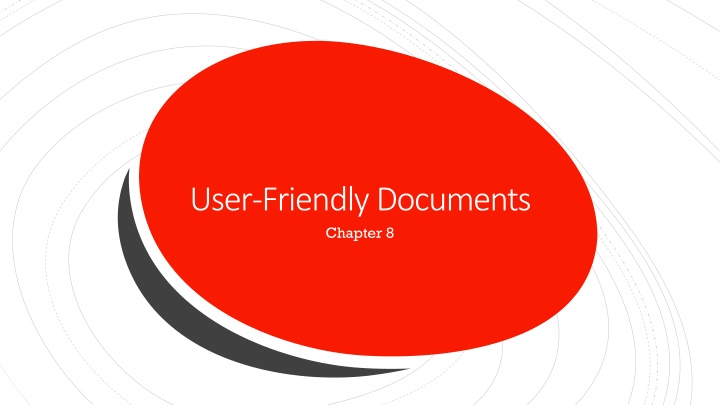
Optimizing Documents with Graphics for Enhanced Communication
Enhance your document's effectiveness with graphics that catch readers' attention, clarify complex information, and communicate with diverse audiences. Explore the benefits, characteristics, and steps for creating effective graphics. Ensure honesty in presenting graphics and consider the audience when planning visuals.
Download Presentation

Please find below an Image/Link to download the presentation.
The content on the website is provided AS IS for your information and personal use only. It may not be sold, licensed, or shared on other websites without obtaining consent from the author. If you encounter any issues during the download, it is possible that the publisher has removed the file from their server.
You are allowed to download the files provided on this website for personal or commercial use, subject to the condition that they are used lawfully. All files are the property of their respective owners.
The content on the website is provided AS IS for your information and personal use only. It may not be sold, licensed, or shared on other websites without obtaining consent from the author.
E N D
Presentation Transcript
User-Friendly Documents Chapter 8
Using Graphics
1. They catch readers attention and interest. 2. They help writers communicate information that is difficult to communicate with words. 3. They help writers clarify and emphasize information. Graphics serve 5 functions: 4. They help nonnative speakers of English understand information. 5. They help writers communicate information to multiple audiences with different interests, aptitudes, and reading habits.
Benefits that graphics offer: Graphics are indispensable in demonstrating logical and numerical relationships. Graphics can communicate spatial information more effectively than words alone. Graphics can communicate steps in a process more effectively than words alone. Graphics can save space. Graphics can reduce the cost of documents intended for international readers.
1. It serves a purpose. 2. It is simple and uncluttered. 3. It presents a manageable amount of information. Effective graphics have 5 characteristics: 4. It meets readers format expectations. 5. It is clearly labeled.
Creating graphics includes 4 steps: PLANNING PRODUCING REVISING CITING SOURCES
audience purpose of the graphic and the document When planning graphics consider: kind of information you want to communicate physical conditions in which readers will use the document
Cite your source and obtain permission. Include all relevant data. Begin the axes in your graphs at zero or mark them clearly. Presenting graphics honestly: Do not use a table to hide a data point that would be obvious in a graph. Show items as they really are. Do not use color or shading to misrepresent an item s importance.
use existing graphics 4 approaches to creating graphics: modify existing graphics create graphics on a computer have someone else create the graphics
1. Place the graphic in an appropriate location. 2. Introduce the graphic in the text. 5 guidelines to integrating graphics with text: 3. Explain the graphic in the text. 4. Make the graphic clearly visible. 5. Make the graphic accessible.
Commonly used graphics TABLES BAR GRAPHS INFOGRAPHICS LINE GRAPHS PIE CHARTS
Indicate the units of measure. In the stub the left-hand column list the items being compared. In the columns, arrange the data clearly and logically. Do the math. Provide footnotes where necessary. Tables
Make the proportions fair. If possible, begin the quantity scale at zero. Use tick marks marks along the axis to signal the amounts. Place the title below the figure. Indicate the source of your information. Bar graphs
Make a claim. Use accurate data. Write concisely. Don t present too much information. Don t go on forever. Test the infographic. Infographics
If possible, begin the quantity scale at zero. Use reasonable proportions for the vertical and horizontal axes. Use grid lines horizontal, vertical, or both rather than tick marks when your readers need to read the quantities precisely. Line Graphs
Restrict the number of slices to no more than seven. Put very small quantities together in one slice. Place a label (horizontally, not radially) inside the slice. To emphasize one slice, use a bright, contrasting color or separate the slice from the pie. Don t overdo fill patterns. Check that your percentages add up to 100. Pie Charts
checklists flowcharts techniques for showing action or motion Other types of graphics you may need to use: photographs screen shots line drawings maps
Motion or Action:
Photographs Eliminate extraneous background clutter that can distract readers. Do not electronically manipulate the image. Help readers understand the perspective. If appropriate, include a common object in the photograph to give readers a sense of scale. If appropriate, label components or important features.
Creating graphics for multicultural readers: Be aware of varying cultural attitudes toward giving instruction. Be aware that reading patterns differ. Deemphasize trivial details. Avoid culture-specific language, symbols, and references. Be particularly careful in portraying hand gestures. Portray people very carefully.
